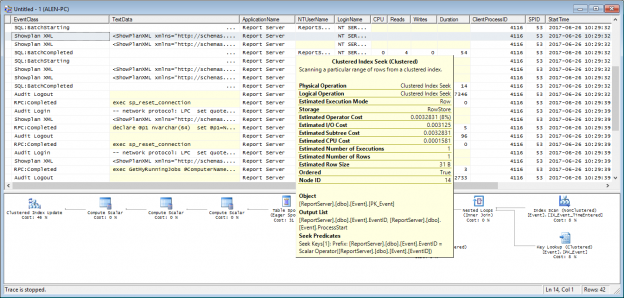


SQL Server security and Policy Based Management – In practice
March 16, 2014
SQL Server security and Policy Based Management – Introduction
March 16, 2014
Using SSIS packages to import MS Excel data into a database
March 15, 2014

SQL Server query execution plans – Viewing the plans
March 15, 2014In the SQL Server query execution plans – Basics, we described the query execution plans in SQL Server and why they are important for performance analysis. In this article, we will focus on the methods for opening the plans, both actual and estimated ones
Read more »
SQL Server query execution plans – Basics
March 15, 2014Why is query execution important for SQL Server performance?
SQL Server performance monitoring depends on the performance goals. The first step in monitoring is to determine optimal performance for your server and create performance trends based on the captured metric information. If performance is not satisfactory, it’s necessary to diagnose performance problems and find their origin. This involves testing how different queries and applications affect performance Read more »
What is SQL Server database mirroring?
March 15, 2014
SQL Server alerts in troubleshooting performance issues: How to create and use SQL Server alerts
March 15, 2014Before creating a SQL Server alert, make sure that Database Mail and SQL Server Agent properties are properly configured Read more »

SQL Server alerts in troubleshooting performance issues: SQL Server alerting basics
March 14, 2014Why is SQL Server alerting important?
To be aware of what’s going on with your system and how SQL Server performs, monitoring is necessary. However, just monitoring might not be enough. Being notified about a performance issue whenever a specific SQL Server counter meets a threshold value, or a specific event occurs, boosts monitoring usability. These notifications enable DBAs to be aware of every important system performance change as soon as it happens, and therefore they can act immediately to fix the issue and prevent further problems Read more »
What is a SQL Server disaster recovery?
March 14, 2014
What is a SQL Server failover clustering
March 14, 2014What is a failover cluster?
SQL Server failover clusters are made of group of servers that run cluster enabled applications in a special way to minimize downtime. A failover is a process that happens if one node crashes, or becomes unavailable and the other one takes over and restarts the application automatically without human intervention Read more »
A database back up task via SQL Server Maintenance Plans
March 14, 2014
SQL Server Maintenance Plans – benefits, features, and functionalities
March 14, 2014
Troubleshooting SQL Server issues with sys.dm_os_performance_counters
March 13, 2014sys.dm_os_performance_counters
sys.dm_os_performance_counters is a system Dynamic Management View (DMV) that returns one row for each SQL Server performance counter. It’s useful for obtaining information about current performance counter values. These counter values are also shown in Windows Performance Monitor, besides other operating system counters Read more »
Ways to use and execute SQL Server Integration Services packages
March 13, 2014
A DBA guide to SQL Server performance troubleshooting – Part 2 – Monitoring utilities
March 13, 2014
A DBA guide to SQL Server performance troubleshooting – Part 1 – Problems and performance metrics
March 13, 2014
SQL Server network performance metrics – The most important metrics
March 13, 2014
SQL Server performance tuning using Windows Performance Monitor
March 12, 2014
Windows Performance Monitor basics
March 12, 2014Read more »

SQL Server disk performance metrics – Part 2 – other important disk performance measures
March 12, 2014
SQL Server disk performance metrics – Part 1 – the most important disk performance metrics
March 12, 2014
SQL Server processor performance metrics – Part 4 – processor metrics useful for deeper investigation and troubleshooting
March 12, 2014In the previous part of this series, we presented the processor metrics that indicate hardware component problems that can affect SQL Server performance
In this part, we will present processor metrics that are not necessary in every performance monitoring scenario, but are useful for deeper investigation and troubleshooting Read more »
SQL Server processor performance metrics – Part 3 – measures that indicate hardware component problems
March 11, 2014
SQL Server processor performance metrics – Part 2 – Processor: % User Time, Processor: % Privilege Time, total times and thread metrics
March 11, 2014In SQL server processor performance metrics – Part 1 – The most important cpu metrics, we described the Processor Queue Length and two most important processor time counters – Processor % Processor Time and Process % Processor time
In this part, we will continue describing important time processor counters Read more »